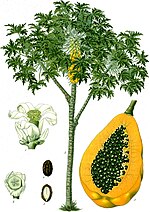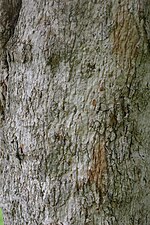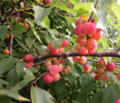(R)-prunasin is a cyanogenic glycoside related to amygdalin. Chemically, it is the glucoside of (R)-mandelonitrile. Prunasin is found in species in the...
14 KB (1,332 words) - 16:37, 5 January 2024
In enzymology, a prunasin β-glucosidase (EC 3.2.1.118) is an enzyme that catalyzes the chemical reaction (R)-prunasin + H2O ⇌ {\displaystyle \rightleftharpoons...
1 KB (95 words) - 15:36, 26 August 2023
acids Polysaccharides Glucans mannans inulin (8) Cyanogenic glycosides Prunasin Sesquiterpene lactones (of the germacranolide type) 11β, 13-dihydrolactucin...
8 KB (806 words) - 06:36, 2 September 2024
Mandelonitrile is the aglycone part of the cyanogenic glycosides prunasin and amygdalin. Prunasin can be hydrolyzed by the enyzme prunase into glucose and mandelonitrile...
4 KB (202 words) - 20:57, 1 November 2024
humans seem to have selected for them. Examples include amygdalin and prunasin which are made by the bitter almond tree; other species that produce cyanogenic...
16 KB (1,893 words) - 04:59, 27 August 2024
glycoside derived from the aromatic amino acid phenylalanine. Amygdalin and prunasin are common among plants of the family Rosaceae, particularly the genus...
33 KB (3,389 words) - 15:52, 3 November 2024
Several varieties of passion fruit are rich in polyphenols, and some contain prunasin and other cyanogenic glycosides in the peel and juice. Purple passion fruit...
7 KB (782 words) - 22:34, 27 October 2024
glycosides Nitrogen-containing 60 Amygdalin, Dhurrin, Linamarin, Lotaustralin, Prunasin Glucosinolates Nitrogen-containing 100 Alkamides Nitrogen-containing 150...
23 KB (2,992 words) - 02:08, 11 November 2023
\rightleftharpoons } (R)-prunasin + D-glucose Thus, the two substrates of this enzyme are (R)-amygdalin and H2O, whereas its two products are (R)-prunasin and D-glucose...
2 KB (181 words) - 13:09, 26 August 2023
red flesh (table). Papaya seeds also contain the cyanogenic substance prunasin. The green fruit contains papain, a cysteine protease enzyme used to tenderize...
35 KB (3,799 words) - 03:49, 31 October 2024
a tree species in the genus Olinia native to South Africa and Lesotho. Prunasin, a cyanogenic glucoside, can be found in the leaves of O. emarginata. List...
1 KB (106 words) - 15:50, 8 October 2023
[clarification needed] These enzymes include amygdalin beta-glucosidase, prunasin beta-glucosidase and mandelonitrile lyase. In contrast, although the flesh...
20 KB (2,084 words) - 13:32, 2 November 2024
the presence of water, acts on the two soluble glucosides amygdalin and prunasin yielding glucose, cyanide and the essential oil of bitter almonds, which...
67 KB (7,035 words) - 15:08, 19 October 2024
polyphenol content. Yellow varieties of the fruit were found to contain prunasin and other cyanogenic glycosides in the peel and juice. Passion fruit is...
27 KB (3,208 words) - 04:33, 3 October 2024
livestock, contains a potentially poisonous cyanogenic glycoside called prunasin. Mature seeds are to be avoided, as the native people did. The young, unripe...
10 KB (1,044 words) - 12:21, 30 August 2024
(i.e. the hydrolysis of cellulose) Glucosylceramidase, a related enzyme Prunasin β-glucosidase Vicianin β-glucosidase PDB: 3AHX; Jeng WY, Wang NC, Lin...
14 KB (1,535 words) - 03:50, 3 November 2024
molecular formula C14H17NO6 (molar mass: 295.29 g/mol) may refer to: Indican Prunasin, a cyanogenic glucoside Sambunigrin, a cyanogenic glucoside This set index...
320 bytes (57 words) - 08:07, 6 January 2021
a member of the genus Prunus, P. nipponica would contain amygdalin and prunasin which form hydrocyanic acid when combined with water. This acid is poisonous...
5 KB (552 words) - 10:38, 27 April 2024
glucoside prunasin. Wikimedia Commons has media related to Olinia ventosa. "Olinia ventosa". Occurrence of the cyanogenic glucoside prunasin and II corresponding...
3 KB (343 words) - 20:33, 12 January 2024
1016/0003-9861(84)90142-5. PMID 6230992. Poulton JE, Shin SI (1983). "Prunasin biosynthesis by cell-free-extracts from black cherry (Prunus serotina Ehrh)...
2 KB (155 words) - 18:23, 23 January 2024
obtained from the leaves. Plants in the Prunus species contain amygdalin and prunasin, substances which break down in water to produce hydrogen cyanide. Hydrogen...
4 KB (423 words) - 23:31, 12 September 2024
those from the fruit, a dark grey to green. Chemically, amygdalin and prunasin, the derivatives of which produce prussic acid as well as Genistein can...
5 KB (428 words) - 16:46, 25 December 2023
obtained from its leaves. Plants in the Prunus species contain amygdalin and prunasin, substances which break down in water to produce hydrogen cyanide. Hydrogen...
5 KB (416 words) - 23:30, 12 September 2024
Poulton JE (1982). "A rapid and sensitive spectrophotometric assay for prunasin hydrolase activity employing purified mandelonitrile lyase". Anal. Biochem...
15 KB (1,703 words) - 14:08, 22 September 2024
butterflies and bees. All members of the genus Prunus contain amygdalin and prunasin. These compounds are found in leaves and seeds. These substances can form...
9 KB (1,059 words) - 14:39, 25 December 2023
4-α-maltotriohydrolase EC 3.2.1.117: amygdalin β-glucosidase EC 3.2.1.118: prunasin β-glucosidase EC 3.2.1.119: vicianin β-glucosidase EC 3.2.1.120: oligoxyloglucan...
119 KB (15,555 words) - 06:24, 19 September 2024
Eastern tent caterpillar (Malacosoma americanum) contains a toxin called prunasin that impacts livestock, specifically horses. The caterpillars let out their...
31 KB (3,771 words) - 02:43, 8 October 2024
Saez, F.; Borch, J.; Dicenta, F.; Moller, B. & Jorgensen, K. (2012). "Prunasin hydrolases during fruit development in sweet and bitter almonds". Plant...
11 KB (1,130 words) - 02:13, 28 November 2023




















